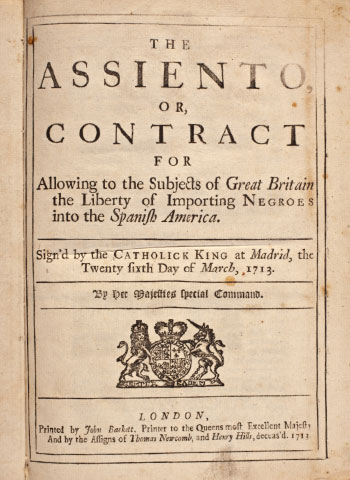Iberian Slave Trade

Portugal and Spain, under the same monarch until 1640, were the pioneers of the transatlantic slave trade. Iberian ports, such as Lisbon, Seville, and Cádiz, outfitted 97 percent of European-based slave voyages up to that date, carrying nearly 500,000 African captives to destinations of toil and death in Spanish America.
In the early years, captives who had first been brought to Spain from Africa were then packed onto slave ships in Spanish ports for transport to New World destinations. By the 1530s, however, the trade had shifted direction, as Iberian ships sailed first to the African coast for captives, then on to the Americas.
After 1545, when Spain signed Asiento agreements authorizing other nations to transport Africans to Spanish colonies, the scale and nature of transatlantic slave trading changed once again. Thereafter, the trade to Spanish colonies was opened to all comers, and Portuguese slave traders soon became a more familiar sight in African and American ports. Before 1641, 240,000 Africans were transported to the Spanish colonies in the Caribbean and in Central America, but a larger number—337,000—were deposited in Recife, Salvador da Bahia, Rio de Janeiro, and other Brazilian coastal cities. Indeed, until that time, about 75 percent of all the 834,000 Africans forced onto slave ships were transported by Portuguese traders, most of whom were based in Brazilian ports.
From the mid-seventeenth century onward, the rise of British naval and commercial power saw the emergence of an enormous British transatlantic slave trade in the North Atlantic. Between 1543 and 1810, British slave traders loaded more than 3.2 million Africans aboard ships destined largely for the Caribbean.
Though all major European maritime powers (and increasingly, North American merchants) involved themselves in slave trading, the transatlantic slave trade continued to be dominated by the Portuguese, especially after Britain and the United States passed laws in the early nineteenth century that made the trade illegal. From 1526 to 1867, the Portuguese loaded 5,783,000 Africans for Brazil, with an estimated 2,208,000 captives shipped in an illegal slave trade between 1808 and 1867.
History & Memory
Related Pages:
-
 EUROTAST
EUROTAST
-
 The Water Carrier
The Water Carrier
-
 Plaque commemorating the arrival of the first enslaved people
Plaque commemorating the arrival of the first enslaved people
-
 Gregoria López
Gregoria López
-
 Buenaventura Lucumí
Buenaventura Lucumí

